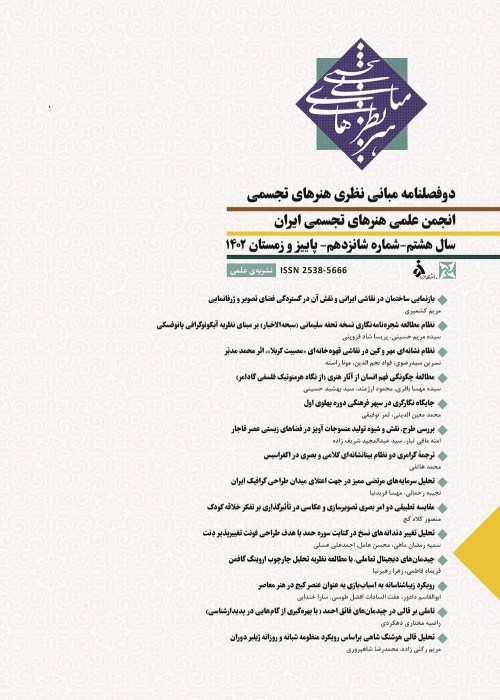Revision of the theory of design as a disciplineContent analysis of contemporary design methodology
Author(s):
Article Type:
Research/Original Article (دارای رتبه معتبر)
Abstract:
Methodological design studies began in early 1950s. Primarily, these studies aimed at understanding design as a scientific discipline, but around 1970s, design methodology studies shifted toward recognizing design as an independent intellectual discipline. As a result of this change in research strategy, the next decades saw the emergence of a comprehensive, coherent and inclusive understanding of design in a way that this new understanding, aligned approaches and theoretical frameworks of the design studies, like a paradigm. In his noticeable book “Designerly Ways of Knowing”, Nigel Cross examines the dimensions of this paradigm and calls it “Design as a discipline”. This understanding of design is still appreciated by researchers and even today, most of design studies are guided by this paradigm; however, since the early years of this century, scattered researches have been conducted in various design areas that reflect the emergence of a new type of understanding design. However, this new understanding has not yet been analyzed and identified well enough. Hence, the purpose of this study is to identify this new paradigm and determine its theoretical framework. To this purpose, a qualitative study was conducted through gathering documents using descriptive method of research for content analysis. Primary sources as erll as those mostly cited texts available in the field of design methodology (since 1950 to date), were widely consulted, reviewed and analyzed. Content analyse phase concentrated on extracting analytical units pertaining to the theoretical framework, objectives, methods and contextual stimuli. Next, extracted contents and analytical units were classified in three categories: “Understanding design thinking”, “Understanding design problem” and “Understanding the problem solving process”. In the next phase, each of the analytical units of these groups were compared and contrasted, synchronically and diachronically. To better report on the research process, the article body first presents the literature review on design methodology and begins with describing the "science of design", with emphasis on Herbert Simon's researches made during the 1960s. Then, it presents a review of the critiques using Descartes method in the analysis of the science of design; those that led to the formation of the second generation of design methodology in the 1970s. The second generation of design methodology is based on Horst Rhyttle's viewpoints; however, in the 80's, the second generation was criticized and revised. After these reforms, the second generation of methodology achieved coherence of theory in 1990s. As mentioned earlier, in the remainder of this article, the contents of design theory as a discipline have been presented in three categories (i.e. thinking, problem, and problem solving). In the field of design thinking, the article indicates two types of contents generated in two study groups of empirical and logical studies. These contents have led to the recognition of the autonomy of design thinking. In the field of design problem, contents are focused on the concept of "wild problem". While for of problem solving, two types of contents have been identified. First and foremost, design problem solving is not a chain of regular and deterministic activities, and second, understanding the design problem requires having an initial solution. In the discussion section, the contents of the contemporary researches have been compared and contrasted with these content categories, and on this basis, some changes have been identified in each section. The result of these analyses indicates the change of assumptions on the definition of science, wicked problems, solution driven problem solving in design, and finally, it indicates the phenomenological contents in new studies. Based on these comparisons, three periods in design methodology are identifiable: 1. period of design science, 2. period of design as a discipline, and 3. the period of design as a combination of mental activities. Identification of the coordinates of this third group is the main finding of this study. According to the arguments presented in this article, studies following the paradigm of "design as an independent discipline" have been influenced by contextual and exogenous stimuli to overemphasize the autonomy of design while design methodology is free from those intentions, nowadays. More importantly, at the present time, using new findings in conducting research studies in design thinking, design problem and design problem-solving process; there is a new understanding of design: an understanding that considers design not as a closed system or an independent mental action, but a combination of mental activities. A strong trend in this period of research is the phenomenological tendency. This tendency, concentrates on the process of perceiving and familiarizing the design situation. It allows design to be identified in interaction with precedents and cognitive schematas. Overall, contemporary studies are in line with “design as a discipline”, but they explore the subject on a higher and more complex level and examine the subject using different intellectual principles and methods.
Keywords:
Language:
Persian
Published:
Journal of Theoretical principles of Visual Arts, Volume:4 Issue: 1, 2019
Pages:
141 to 154
magiran.com/p2021840
دانلود و مطالعه متن این مقاله با یکی از روشهای زیر امکان پذیر است:
اشتراک شخصی
با عضویت و پرداخت آنلاین حق اشتراک یکساله به مبلغ 1,390,000ريال میتوانید 70 عنوان مطلب دانلود کنید!
اشتراک سازمانی
به کتابخانه دانشگاه یا محل کار خود پیشنهاد کنید تا اشتراک سازمانی این پایگاه را برای دسترسی نامحدود همه کاربران به متن مطالب تهیه نمایند!
توجه!
- حق عضویت دریافتی صرف حمایت از نشریات عضو و نگهداری، تکمیل و توسعه مگیران میشود.
- پرداخت حق اشتراک و دانلود مقالات اجازه بازنشر آن در سایر رسانههای چاپی و دیجیتال را به کاربر نمیدهد.
دسترسی سراسری کاربران دانشگاه پیام نور!
اعضای هیئت علمی و دانشجویان دانشگاه پیام نور در سراسر کشور، در صورت ثبت نام با ایمیل دانشگاهی، تا پایان فروردین ماه 1403 به مقالات سایت دسترسی خواهند داشت!
In order to view content subscription is required
Personal subscription
Subscribe magiran.com for 70 € euros via PayPal and download 70 articles during a year.
Organization subscription
Please contact us to subscribe your university or library for unlimited access!


